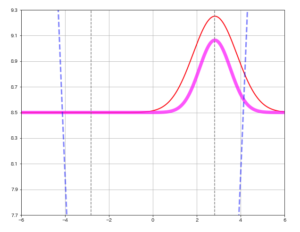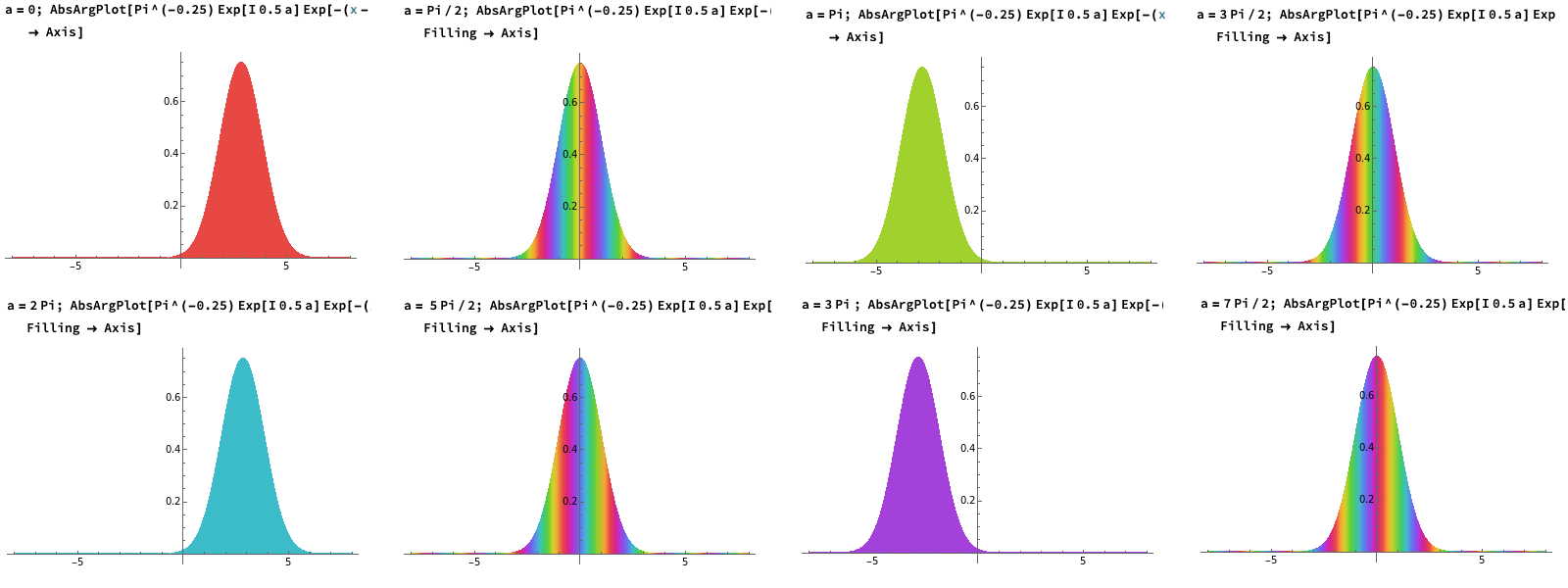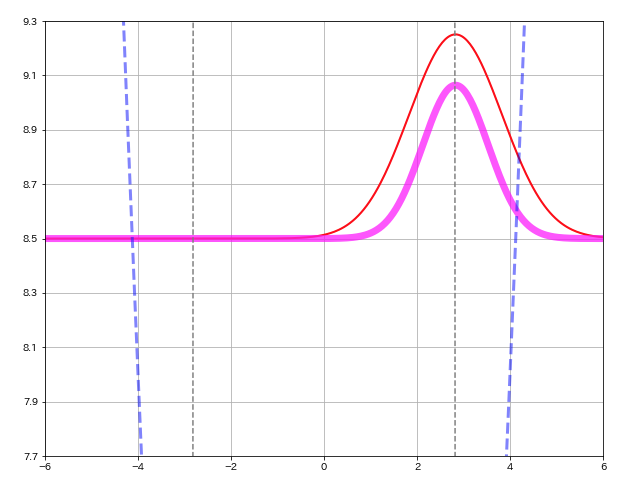前述した「コヒーレント状態」の波動関数は,「形が拡がらずに前後に運動する波束となる」ことが期待される.実際, コヒーレント状態の波動関数は, そのような時間変化をするであろうか?.詳しく調べて見よう.

前述のブログ記事から,
また, 個数状態の波動関数
従って, 上式 (3.117) に左から
ここで, 一般に
すると上式は次に書ける:
ここで更に,「エルミート多項式の母関数( generating function )」
このときの
従って, 確率密度
これは,『確率密度関数はガウス波束であり, その中心が「振幅が
このことを示すために, 式 (5) の「コヒーレント状態の波動関数」
1 2 3 4 5 6 7 8 9 10 11 12 13 14 15 16 17 18 19 20 21 22 23 24 25 26 27 28 29 30 31 32 33 34 35 36 37 38 39 40 41 42 43 44 45 46 47 48 | import numpy as npimport mathimport matplotlib.pyplot as pltfrom matplotlib import animation, rcfrom IPython.display import HTML# Figureのインスタンス生成fig, axe = plt.subplots(1, 1, figsize=(10, 8))amp = math.pow(math.pi, -1/4)alpha =2dt=1/25T=2*math.pi/dttime = math.ceil(2*T)x0 = alpha*math.sqrt(2)x = np.linspace(-6, 6, 400)sift=x0*x0+0.5ims = []for t in range(time): pt= -x0*math.sin(t*dt) xt= x0*math.cos(t*dt) y = amp*np.exp(-1.j*pt*xt/2-1.j*t*dt/2)*np.exp(pt*x*1.j-(x-xt)**2/2) yy = np.conj(y)*y im1 = axe.plot(x, y.real+sift, linewidth=2, color='red') im2 = axe.plot(x, yy.real+sift, linewidth=7, alpha=0.7, color='magenta') ims.append(im1+im2)anim = animation.ArtistAnimation(fig, ims, interval=80)# 全エネルギー E=T+V+0.5=2V+0.5=2*V(a)+0.5=2*(sqrt(2)*alpha)^2+0.5=2*alpha^2+0.5,hy = 1/2*x*x # harmonic potential V(x)=x^2/2, axe.plot(x,hy, color='blue', linewidth=3, alpha=0.5, linestyle="--")rectangle = 10*np.heaviside(x+alpha*math.sqrt(2),4.5)-10*np.heaviside(x-alpha*math.sqrt(2),4.5)axe.plot(x, rectangle, color='gray', linestyle="--") # ground state is sifted a=sqrt(2)*alphaaxe.set_xlim([-6, 6])axe.set_ylim([sift-0.8, sift+0.8]) axe.set_yticks([7.7, 7.9, 8.1, 8.3, 8.5, 8.7, 8.9, 9.1, 9.3])axe.grid()#axe.legend()# Jupyter notebookの場合は#plt.show()# Google Colaboratoryの場合必要rc('animation', html='jshtml')plt.close()anim |
【 補足 】 波動関数の周期的な時間依存性
複素数であるコヒーレント状態の波動関数
そこで Wolfram Cloud によって, 複素数である式 (5) のコヒーレント状態波動関数をカラー表示でグラフ化したものを示しておく:

図 1. 複素数のカラー表示手法によって, コヒーレント状態の波動関数
図は時間間隔
7.3.2. 周期的な時間依存性
1次元調和振動子の量子力学的状態の時間発展は,「時間依存するシュレディンガー方程式」によって記述される:
この方程式の一般解は, そのエネルギー固有関数
このとき, 式 (2) から次のことが言える:
【 振動状態の時間対称性 】
調和振動子ポテンシャルのシュレディンガー方程式の任意の解は次の特性を持つ:
従って,
【 振動状態の周期的な時間依存性 】
全ての初期状態に対して, 式 (1) の解 の周期は である.しかし, 「波動関数」 の周期は であるけれども, 量子力学的「状態」(そして特に位置の確率密度 ) の周期は となる.それは, 相当する古典力学系の周期に等しい.


